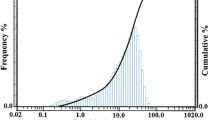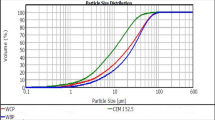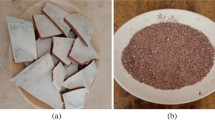Abstract
Waste ceramic polishing powder, as a type of waste common in the ceramic industry, is produced during grinding and polishing of ceramic tiles. In this paper, waste ceramic polishing powder, as a supplementary cementitious material, was used for the preparation of concrete. With the aid of tests, this paper discusses the effects of waste ceramic polishing powder on the permeability resistance of concrete. In this study, 12 groups of concrete were designed, including one control group; four groups of concrete mixed with waste ceramic polishing powder; four groups of concrete mixed with fly ash; three groups of concrete mixed with waste ceramic polishing powder and fly ash simultaneously, and the cement substitution rate in each group were different. Tests showed that the permeability resistance of the concrete mixed with waste ceramic polishing powder is superior to that of the control group, and in particular, the most desirable permeability resistance is achieved when the cement substitution rate is 30 %; with the difference in the cement substitution rate, the permeability resistance of the concrete mixed with waste ceramic polishing powder varies similarly to that of the concrete mixed with fly ash; the permeability resistance of the concrete mixed with waste ceramic polishing powder and fly ash simultaneously is superior to that of the concrete mixed with either.







Similar content being viewed by others
References
Zeng L, Jin X, Liu Y (2010) Ceramic waste recycling technology[M]. Chemical Industry Press, Beijing, p 6 in Chinese
WANG G (2010) Pozzolanic activity of waste ceramic polishing powder as supplementary cementitious material [J]. J Chin Ceram Soc 38(7):1229–1234 in Chinese
Senthamarai RM, Devadas Manoharan P (2005) Concrete with ceramic waste aggregate [J]. Cem Concr Compos 27:910–913
Binici H (2007) Effect of crushed ceramic and basaltic pumice as fine aggregates on concrete mortars properties [J]. Constr Build Mater 21:1191–1197
de Brito J, Pereira AS, Correia JR (2005) Mechanical behaviour of non-structural concrete made with recycled ceramic aggregates [J]. Cem Concr Compos 27:429–433
Pacheco-Torgal F, Jalali S (2010) Reusing ceramic wastes in concrete [J]. Constr Build Mater 24:832–838
Silvestre R, Medel E, García A, Navas J (2013) Using ceramic wastes from tile industry as a partial substitute of natural aggregates in hot mix asphalt binder courses [J]. Constr Build Mater 45:115–122
Guerra I, Vivar I, Llamas B, Juan A, Moran J (2009) Eco-efficient concretes: the effects of using recycled ceramic material from sanitary installations on the mechanical properties of concrete [J]. Waste Manag 29:643–646
Torkittikul P, Chaipanich A (2010) Utilization of ceramic waste as fine aggregate within Portland cement and coal ash concretes [J]. Cem Concr Compos 32:440–449
Senthamarai RM, Devadas P, Manoharan PD, Gobinath D (2011) Concrete made from ceramic industry waste: durability properties [J]. Constr Build Mater 25:2413–2419
Huang B, Dong Q, Burdette EG (2009) Laboratory evaluation of incorporating waste ceramic materials into Portland cement and asphaltic concrete [J]. Constr Build Mater 23:3451–3456
Pereira-de-Oliveira LA, Castro-Gomes JP, Santos P (2012) The potential pozzolanic activity of glass and red-clay ceramic waste as cement mortars components [J]. Constr Build Mater 31:197–203
Higashiyama H, Yagishita F, Sano M, Takahashi O (2012) Compressive strength and resistance to chloride penetration of mortars using ceramic waste as fine aggregate [J]. Constr Build Mater 26:96–101
Higashiyama H, Sappakittipakorn M, Sano M, Yagishita F (2012) Chloride ion penetration into mortar containing ceramic waste aggregate [J]. Constr Build Mater 31:48–54
Medina C, Sánchez de Rojas MI, Frías M (2012) Reuse of sanitary ceramic wastes as coarse aggregate in eco-efficient concretes [J]. Cem Concr Compos 34:48–54
Higashiyama H, Yamauchi K, Sappakittipakorn M, Sano M, Takahashi O (2013) A visual investigation on chloride ingress into ceramic waste aggregate mortars having different water to cement ratios [J]. Constr Build Mater 40:1021–1028
Zhong M, Zhang Z, Wang G (2010) Hydration ability of waste ceramic polishing powder under normal temperatures and autocalved conditions [J]. China Concr Cem Prod 4:72–74 in Chinese
Wang G, Su D (2008) Performance and mechanism analysis of lime-polishing powder inorganic binder [J]. J Shanxi Univ Sci Technol 26(5):10–15
Su D, Wang G, Zhong X (2008) Study on the pozzolanic activity o f waste ceramic polishing powder [J]. Cem Technol 4:22–24 in Chinese
Wang G, Su D (2008) Study on the performance of lime-polishing powder binder [J]. Highw Eng 33(5):65–68 in Chinese
Wang G, Su D, Zhong X (2008) Effects of waste ceramic polishing powder as admixture on the performance of concrete [J]. Concrete 10:64–66 in Chinese
Wang G, Su D, Zhao Y (2008) Fabrication of autoclaved silicate products with waste ceramic polishing powder as raw material [J]. J South China Univ Technol (Nat Sci Ed) 36(7):124–127,133 in Chinese
Parichatprecha R, Nimityongskul P (2009) Analysis of durability of high performance concrete using artificial neural networks [J]. Constr Build Mater 23:910–917
Mather B (2004) Concrete durability [J]. Cem Concr Compos 26:3–4
Park S-S, Kwon S-J, Jung SH, Lee SW (2012) Modeling of water permeability in early aged concrete with cracks based on micro pore structure [J]. Constr Build Mater 27:597–604
Yang K, Basheer PAM, Magee B, Bai Y (2013) Investigation of moisture condition and Autoclam sensitivity on air permeability measurements for both normal concrete and high performance concrete [J]. Constr Build Mater 48:306–314
Das BB, Kondraivendhan B (2012) Implication of pore size distribution parameters on compressive strength, permeability and hydraulic diffusivity of concrete [J]. Constr Build Mater 28:382–386
Qin Z (2011) Test research of effects of waste ceramic polishing powder on workability and compressive strength of concrete [D]. Thesis for master’s degree in Northeastern University, in Chinese
Qian J (2004) Coal ash characteristics and coal ash concrete. Science Press, Beijing, pp 150–153 in Chinese
Acknowledgements
Supported by Liaoning province natural science foundation (201102064) and the ministry of education key laboratory open funds (solid waste treatment and resource recovery)(12zxgk01).
Author information
Authors and Affiliations
Corresponding author
Rights and permissions
About this article
Cite this article
Cheng, Yh., Huang, F., Liu, R. et al. Test research on effects of waste ceramic polishing powder on the permeability resistance of concrete. Mater Struct 49, 729–738 (2016). https://doi.org/10.1617/s11527-015-0533-6
Received:
Accepted:
Published:
Issue Date:
DOI: https://doi.org/10.1617/s11527-015-0533-6




